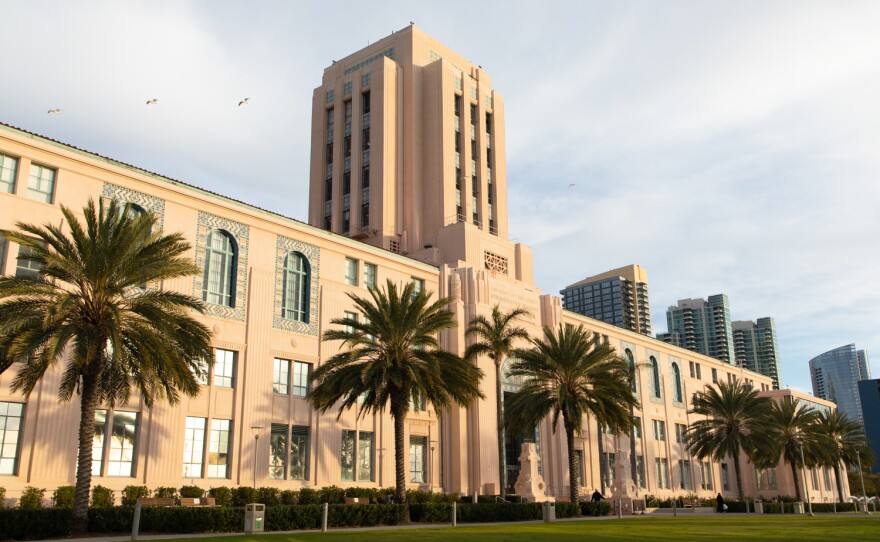A $27 million rental assistance program the county Board of Supervisors launched in August was supposed to help 10,000 low-income families impacted by COVID-19 who had nowhere else to turn.
Greg Cox and Nathan Fletcher, the two supervisors leading the region’s fight against the coronavirus at the time, stressed that the $27 million shouldn’t benefit tenants in cities with money in their own rent relief programs.
But that’s exactly what happened.
An inewsource analysis of ZIP code data shows roughly three-quarters of the county’s money spent through December went to help residents in San Diego, El Cajon, Chula Vista and La Mesa — cities that had rent relief programs and money still to spend.
Nearly half of the households that received help from the county live in San Diego.
For reasons the county would not explain, staff went against the supervisors’ stated wishes and created a standard that ultimately allowed residents in those cities to qualify for the program.
But the standard was not applied across the board.
Tenants in Carlsbad, Escondido, National City and San Marcos, which also had rent relief programs, were not eligible. Officials in National City and Escondido are crying foul.
“If we were excluded, other cities with their own openly available programs should have been excluded as well out of fairness,” said Carlos Aguirre, director of the National City Housing Authority.
National City has been among the hardest hit by unemployment during the pandemic, and the city’s mayor, Alejandra Sotelo-Solis, said all of the county’s COVID-19 resources should be based on need.

“I think there needs to be that deeper dive in how those resources are being distributed,” Sotelo-Solis said.
Mike Strong, Escondido’s Community Development director, said he wants answers from the county about why this happened.
“I think the end goal is to make sure that any eligible recipient, regardless of jurisdiction, is afforded access to the same opportunities,” Strong said.
Last week, the Board of Supervisors approved a new $49 million aid package that goes beyond covering rent. It also helps people with utility and other household expenses. The money comes from federal coronavirus funds.
Expected to roll out this month, the new program will exclude residents in San Diego and Chula Vista because those cities also have received federal aid for these purposes.
But none of this changes the program the supervisors approved in August. Fletcher said at last week’s board meeting the original program still has $13 million to be spent.
inewsource attempted several times to interview Fletcher, now the board chairman, about how the first program unfolded and how he plans to ensure this new one rolls out as intended. His spokesperson did not respond to those interview requests.
A county spokesperson also did not respond to questions about why staffers didn’t follow the board’s directive with the first program.
‘Badly needed’ program
COVID-19 has led to the highest unemployment level since the Great Depression, causing nearly 90,000 California households to fall behind in rent, according to research released last month from the state’s nonpartisan Legislative Analyst's Office.
The average California household with unemployed workers has accumulated nearly $4,500 in rental debt, the study said, and it could have been worse if cities and counties hadn’t created rental assistance programs. Much of the money came from federal coronavirus aid and was based on population.
That meant unincorporated areas and small cities relied on San Diego County for help.

The county’s $27 million rent relief program started with an Aug. 19 letter from Cox and Fletcher requesting a change to the county’s budget.
It stated plainly: “Residents who live within jurisdictions with their own COVID-19 rental relief program would not be eligible for the County program unless those jurisdictions’ funds have already been depleted.”
At a board meeting to discuss the proposal, then-Supervisor Dianne Jacob, who represented East County for 28 years before leaving office last month, said the program was “badly needed.” She asked that priority be given to the 2,000 renters in unincorporated areas who “are on the list, ready to go.”
“I don't know how staff is going to work out priorities, but I want to make sure that these folks are taken care of,” Jacob said.
The measure passed the five-member board unanimously.

But a month later, county staff overseeing the program changed which areas would be eligible.
Residents were excluded from the county’s program only if their city had a rent relief program that was accepting or planning to accept applications at the same time as the county, Michael Workman, a county spokesperson told inewsource in an email. Because San Diego was not accepting applications, their residents qualified for the county program, Workman said.
He did not address why money went to the cities of Chula Vista, El Cajon or La Mesa, and when inewsource told him those cities still had money available for their residents, he offered no explanation. He also didn’t respond to requests to interview the person in charge of the county’s program.
Through December, the county had spent $10.9 million helping more than 4,000 households. About 330 of those are in unincorporated areas, representing about 980 people based on SANDAG’s average household estimates. That’s far fewer than what Jacob had hoped for.
Tenants in some cities had two safety nets
The county’s implementation plan shows that staffers were supposed to consider two things when gauging a city’s eligibility for the rent relief program: The application period and whether money was still available to help tenants.
Using that criteria, San Diego renters shouldn’t have been eligible for the county’s program. San Diego still had more than $9 million in rental assistance when the county started accepting applications in September, according to San Diego Housing Commission records.
The Housing Commission has also been sitting on another $5 million that was approved in October to help renters and has not said when it will spend the money. Mayor Todd Gloria also announced last month a new $42 million rental assistance program.
Meanwhile, the county has spent $4.9 million on rent relief for 1,860 San Diego households.
County spokesperson Workman contended in emails that San Diego residents were eligible for the county’s program all along. But Housing Commission spokesperson Scott Marshall disputes that. He said city residents weren’t eligible for the county’s program until Dec. 1.
By that time, the city’s program had run out of money, which made city residents eligible, Marshall said. But that’s not the complete picture.
Marshall revealed — after inewsource obtained emails between the commission and tenants’ landlords — that the agency continued in December to provide more than $100,000 in rent relief from unused administrative costs.
So far, the city’s program, which was rife with delays, has helped more than 3,700 San Diego households with about $13.7 million, Marshall said.
Concern about inequity in county program
Officials in Escondido and National City said they’re left wondering why their renters were excluded from the county’s multimillion-dollar program.
National City housing official Aguirre said his city wanted to help struggling renters during the pandemic, so officials put together a $558,000 program from various funding sources before the county’s program began.
The City Council approved it in mid-August. Because that money had been set aside, National City residents were ineligible for the county’s rent relief, he said.
The same issue initially excluded Escondido renters from applying for the county program.

Escondido had created a $268,000 rental assistance program from a variety of sources, but tenants weren’t eligible to apply for the aid until they received an eviction notice, said Karen Youel, the city’s Housing and Neighborhood Services manager. With the state’s moratorium on evictions in place, the city’s program wasn’t running.
Because Escondido had money available — even though it couldn’t be spent — county officials excluded those residents, said Strong, the city’s community development director.
Escondido put its program on hold in mid-November so residents could qualify for county money.
An inewsource analysis found that at most 109 Escondido households received about $295,000 in rental assistance from the county through the end of December.
Escondido Mayor Paul McNamara told inewsource he is “concerned about what appears to be an inequity” in how the county program worked, and he will ask city staff to investigate.

Just before leaving the Board of Supervisors in January, Cox suggested that the county’s program didn’t roll out as it was intended.
“We did say that residents who live in cities with their own COVID-19 rental relief program would not be eligible for the County program, unless their cities’ funds had already been depleted,” Cox said in an email to inewsource. “We hope this program can help as many people as possible during this difficult time.”
inewsource investigative data reporter Jill Castellano and web producer/reporter Bella Ross contributed to this story.







